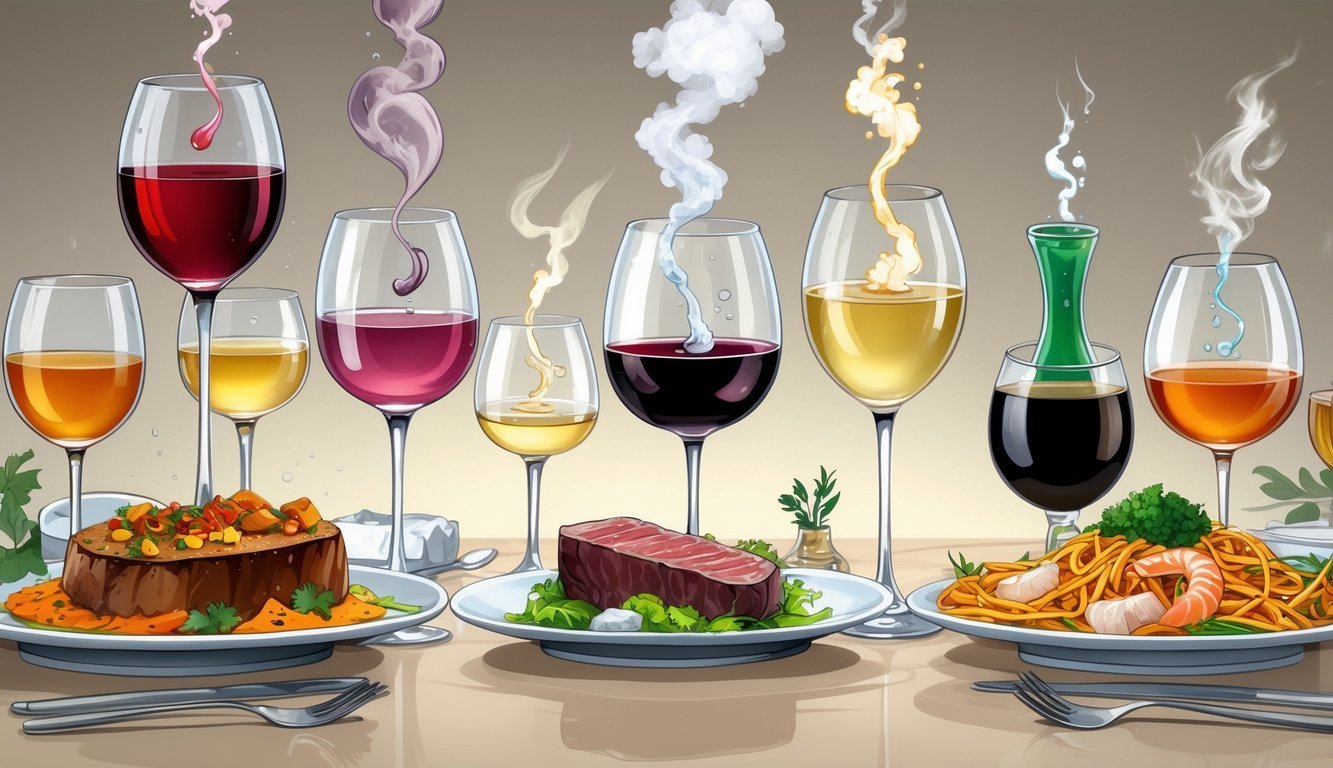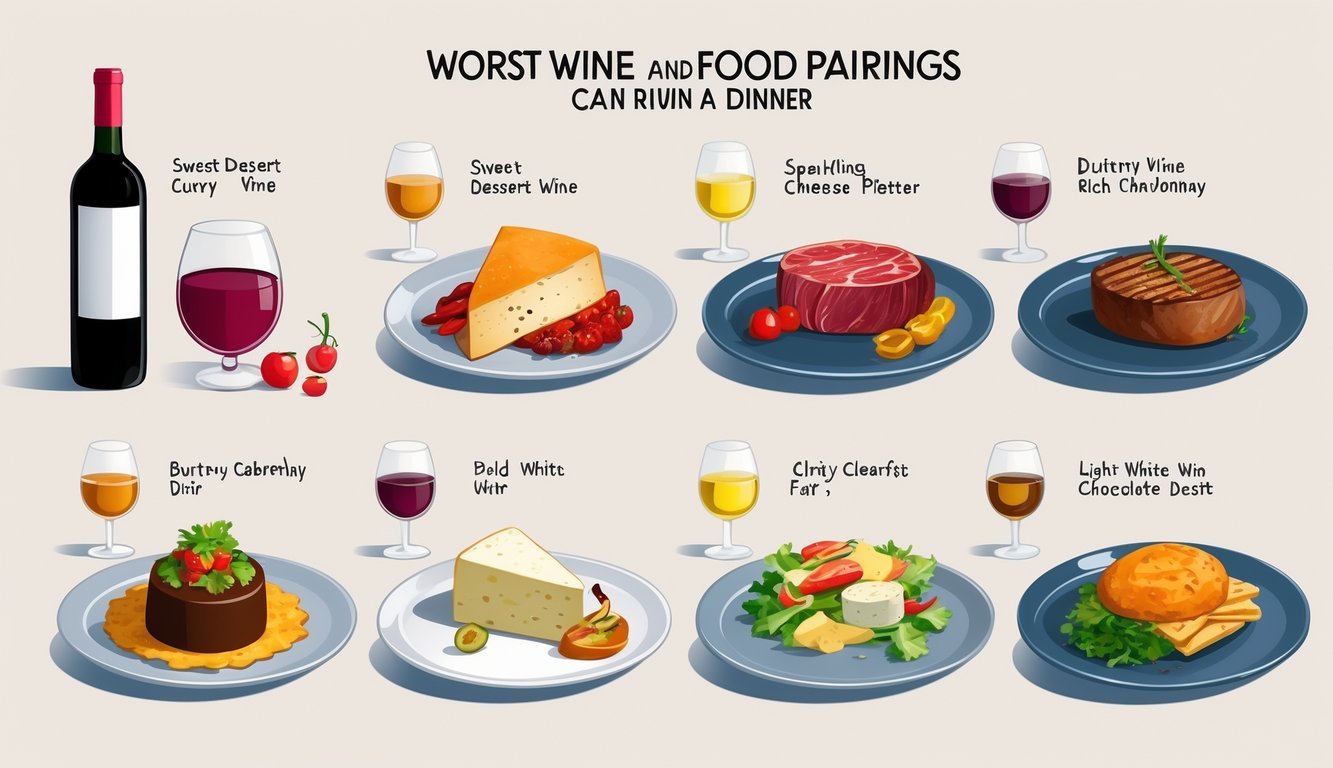Physical Address
304 North Cardinal St.
Dorchester Center, MA 02124
Physical Address
304 North Cardinal St.
Dorchester Center, MA 02124
Pairing wine with food requires careful consideration to avoid clashing flavors, especially with spicy dishes, creamy sauces, and certain vegetables that can overpower wines.

Pairing wine with food can totally transform your meal, but let’s be honest—some combos just wreck it. Learning about the worst wine and food pairings might actually save your dinner.
Certain foods and wines just argue on your tongue, and nobody wants that.
You might think any wine will work with your favorite dish, but nope, not always.
Red wine, for example, usually doesn’t get along with veggies like artichokes or asparagus.
Heavy wines and rich, sweet desserts? They just overwhelm your palate.
If you dodge these bad matches, you’ll actually enjoy both your food and wine.
Let’s walk through seven pairings you’ll want to skip if you’re aiming for a smooth, tasty dinner.
Are you tired of spinning your wheels and getting nowhere? Simply put, you’re out of sync: you’re out of alignment with your astral configuration.
But: there’s a kind of map that can help you reclaim your alignment. Think of it as your own personal blueprint to success and happiness: a blueprint that will help you live your most amazing life.
Get started here.

Some wine and food combos simply don’t work because their flavors end up fighting.
Sometimes the acidity feels too sharp, sometimes everything feels too heavy, or maybe the flavors just crash into each other.
If you know which pairs to avoid, you can save your dinner from a letdown.
Chardonnay brings those buttery, creamy flavors and a soft, smooth texture.
It doesn’t have much acidity, and that’s where things go wrong with spicy food.
If you eat something spicy—think chili or curry—the heat just steamrolls Chardonnay’s gentle taste.
The spice makes Chardonnay taste flat.
Those buttery notes don’t help; they just sit awkwardly with the heat.
Instead of cooling things down, Chardonnay can actually make the spice feel even hotter.
Not ideal.
If you’re eyeing spicy food, try a wine with more acidity or a little sweetness, like a Riesling.
They handle spice way better.
Cabernet Sauvignon is bold, full-bodied, and packs strong tannins with flavors like black fruit and oak.
Those tannins, though, can make delicate dishes taste bitter.
If you put Cabernet next to white fish or a simple salad, it just bulldozes the food.
The wine’s strength hides the subtle flavors, and suddenly your meal feels off balance.
Stick to serving Cabernet with richer dishes—steak or lamb, for example.
That’s where it shines.
Sauvignon Blanc is crisp, zippy, and full of citrus and grassy notes.
Creamy sauces, meanwhile, bring richness and fat.
Mix the two, and the wine’s acidity just smacks into the sauce’s richness.
You might notice the wine feels too sharp, and the sauce gets even heavier.
It’s not a pleasant mix and can leave a weird aftertaste.
Creamy dishes do better with wines that have less acidity and more body, like a lightly oaked Chardonnay.
Sparkling wine has bubbles and plenty of acidity, so it’s great for light foods and appetizers.
But with steak? That’s a tough sell.
The steak’s strong flavors and fat don’t mix well with sparkling wine’s sharp, fizzy texture.
The bubbles just clash with the richness and any spice in the meat.
The acidity can even make the wine taste sour against the steak’s juicy fat.
Go for a fuller-bodied red like Cabernet Sauvignon or Malbec with steak.
That match just makes more sense.

Pairing wine and food isn’t as simple as it sounds.
Flavors have to balance, or things get weird fast.
Some combos look good on paper but fall apart because of acidity, spice, or just too much richness.
Rosé feels light and fresh, so it works with a lot of foods.
But if you put it next to strong flavors—like spicy sausages or a heavy stew—it just disappears.
The bright acidity and fruitiness can’t compete with bold spices and rich, fatty bites.
If your dish brings heat or heavy seasoning, rosé might taste thin or even sour.
Try a Grenache with spice or a Viognier for creamy sauces.
Otherwise, your wine might not wow anyone at the table.
Merlot’s smooth, soft tannins and berry flavors fit plenty of dishes.
But spicy Asian food? Not so much.
The wine’s sweetness and mild tannins don’t get along with heat and strong spices—like in Thai curry or Szechuan chicken.
Spicy food can make Merlot taste bitter and hide its fruitiness.
It ends up flat.
Wines with more acidity or a hint of sweetness, like Riesling or even sake, balance spice better.
Something to keep in mind for your next takeout night.
Pinot Noir is famous for being food-friendly thanks to its light body and good acidity.
But it doesn’t always work with oily fish—think salmon or mackerel.
The wine’s earthiness and tannins can collide with those strong fish oils.
If you’re serving light, flaky fish, Pinot Gris or a crisp white will probably work better.
Pinots from Burgundy have complex flavors, but they can overpower some seafood.
If you love Pinot Noir, pair it with lighter fish or dishes that have mushrooms or root veggies.

Pairing wine with food feels tricky sometimes.
Some wines just don’t play nice with certain flavors, textures, or spices.
Knowing what not to do really helps keep your meal enjoyable.
Don’t pair red wine with bitter veggies like artichokes or Brussels sprouts.
Spicy foods usually don’t get along with most wines.
Sweet foods can totally overpower dry wines and make the pairing taste off.
Artichokes, asparagus, and strong green veggies often fight with wine flavors.
Spicy dishes and salty foods—like caviar—tend to clash with a lot of wines.
Rich, creamy, or buttery dishes can cover up the wine’s flavor.
Heavy sauces and super sweet desserts, like chocolate, often drown out the wine.
High acidity in wine can make sour foods taste even sharper.
Sweet wines and salty or spicy dishes? That combo can feel unbalanced.
Strong spices—hot chili, curry, heavy pepper—can just overwhelm most wines.
They might make your wine taste bitter or hide its flavor completely.
Tannic red wines just don’t get along with creamy or fatty foods.
The flavors can really clash, and honestly, the wine might end up tasting kind of harsh.
I’d go for lighter white wines or something with less tannin instead.
Those options usually feel smoother and more balanced with rich dishes.